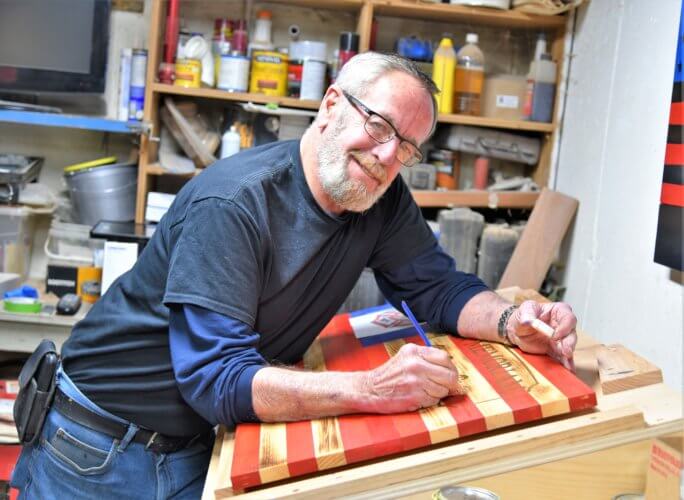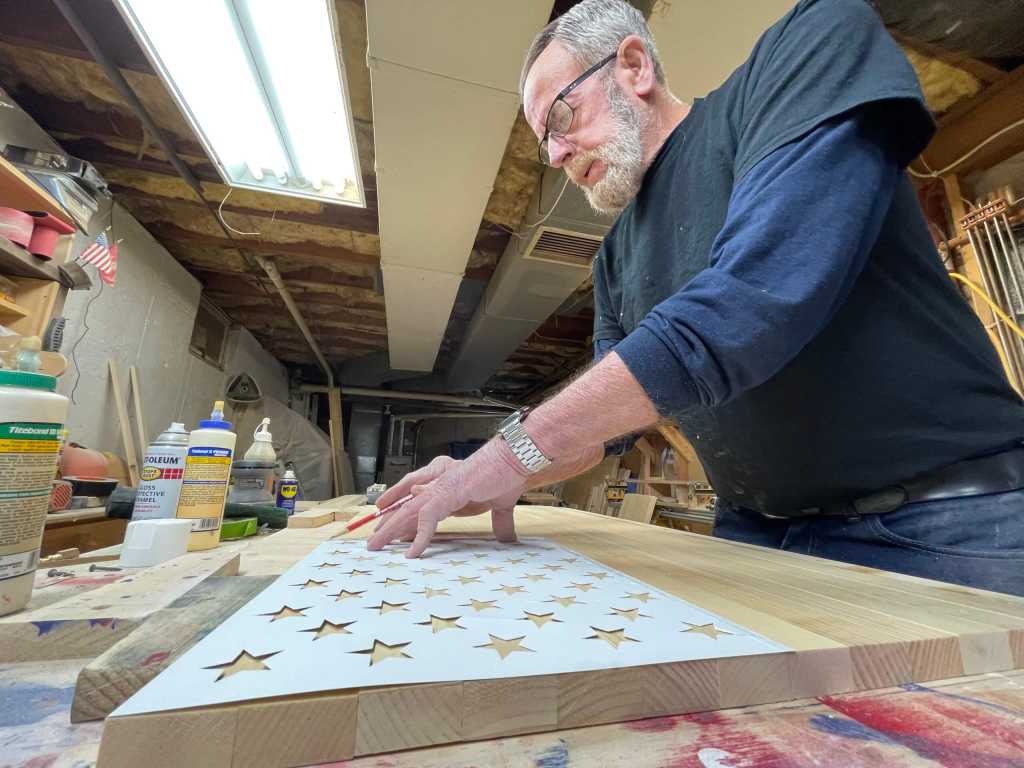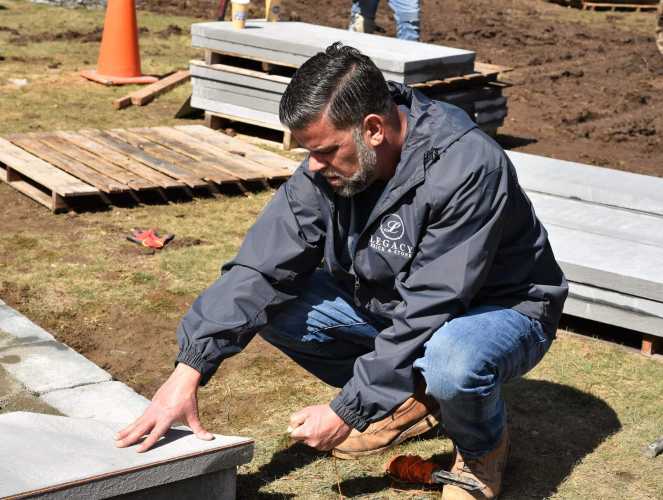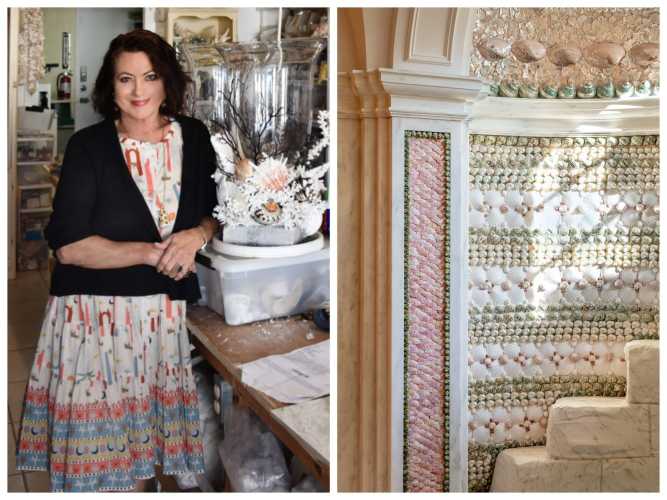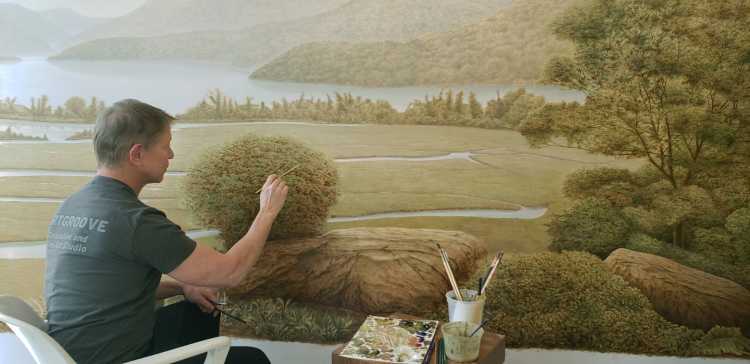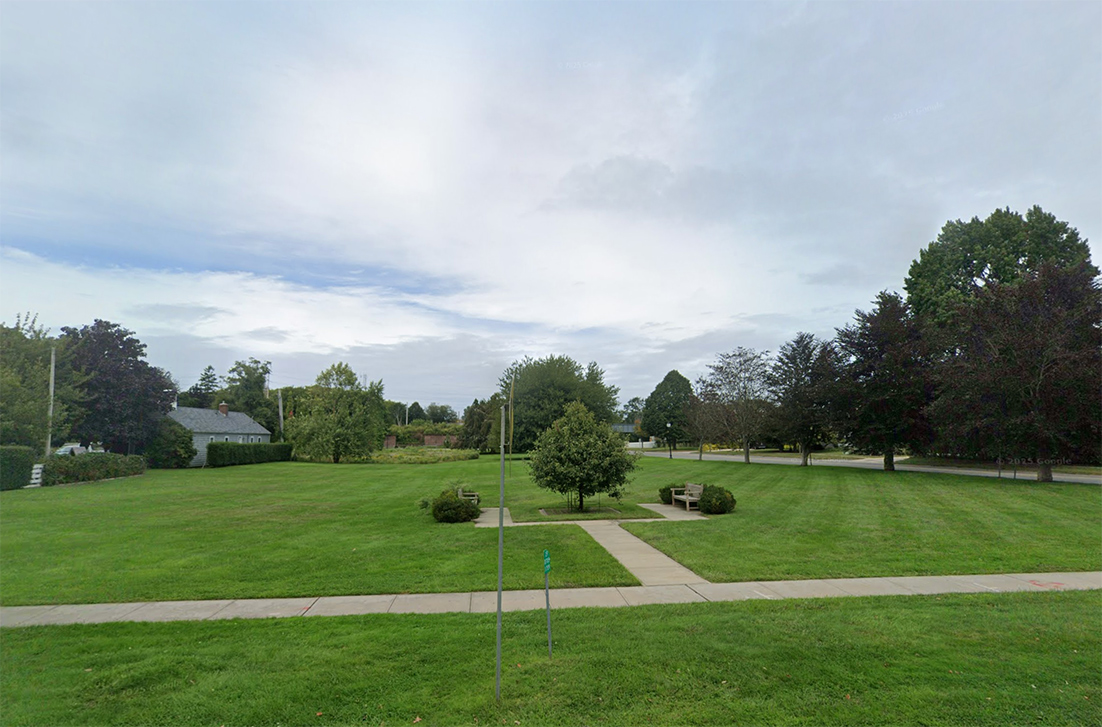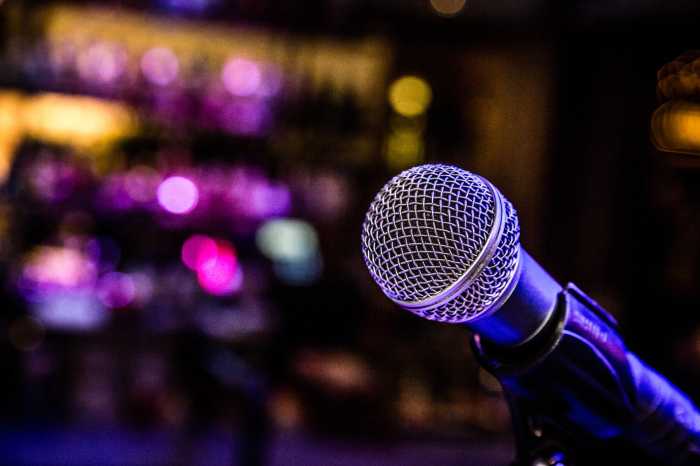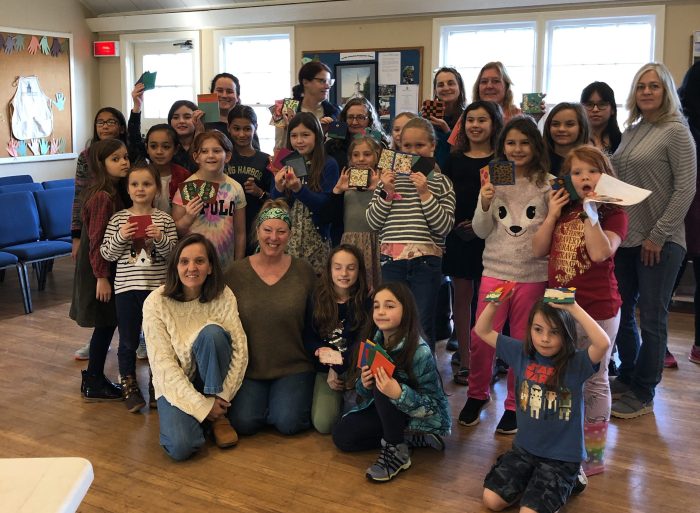Ray Card has been a carpenter for 47 years. A skilled woodworker from Sag Harbor, he has done everything from working on a 14,000-square-foot house to small jobs, from $30,000 cabinetry projects to repair work.
None has been more meaningful to both him and his customers than his most recent endeavor creating handcrafted American flags that not only serve as a patriotic symbol to display, but pay homage to people’s service.
“This whole thing started two years ago,” Card explains one Saturday afternoon in his home shop. “It was a shock two years ago when I had like three jobs going, I had two guys working with me and all of a sudden people call me up and said, ‘You can’t work here no more’ because of the pandemic.”
He was left with the question a lot of people were asking as the COVID-19 shutdown began, “Now what am I going to do?”
He quickly found something to keep his skills sharp.
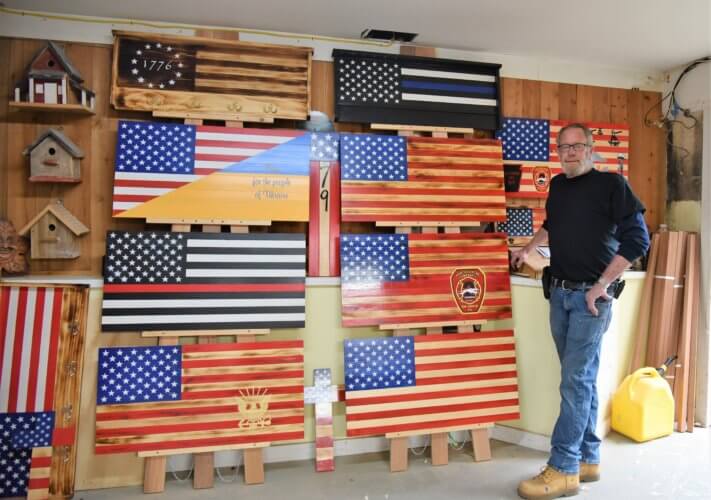
“I was looking online one day and I saw a thing on YouTube about making these wood flags. I said, ‘Well, hell, I can make ‘em!’ So I started out with one or two and I did a fire department logo on them, and guys in my department here in Sag Harbor, they scooped them right up.”
Thanks to social media and sharing photographs with his friends, he realized there was a demand, not just for the decorative pieces, but for high-quality work.
Ray’s Flags are made of pine, not plywood or fence post like many homemade flags that can be seen around the internet. “Some guys just make shit and sell ‘em,” he says with a laugh.
Requests have been pouring in for the flags, typically 38 inches wide by 19-and-a-half inches tall. He’s made them with police department logos, with specific badges, and with the thin blue line symbolizing law enforcement support. For firefighters, there are flags with the thin red line. He’s had special order requests for flags with East End department patches, which are all hand-painted onto the flag.

For his niece in North Carolina who is a nurse, he made one with the caduceus medical symbol. Another niece is a dispatcher in Southold Town and he made her one with a headset.
He’s even done combination designs with a half flag each for two countries. For instance, after Russia began the war with Ukraine, he made one with the American and Ukrainian flags and the words, “Pray for the people of Ukraine.”
“Next thing I knew I was doing like 50 of ‘em, so I said, ‘Let me expand this.’ So that’s when I started making like these coat racks,” he says pointing to a piece of pine painted with an American flag and hooks for hanging.
Also in Card’s repertoire are crosses and holders for challenge coins, which are carried by an organization’s members bearing their insignia or emblem.
It started out as “a way to keep busy and to make a few bucks” during COVID. After his daughter made him a shirt for Christmas that says, “Ray’s Flags,” business cards then followed, a Facebook page called Ray’s Flags, and now it’s a business. But it is not so much a money-making endeavor as a labor of love. He says it’s something with purpose.
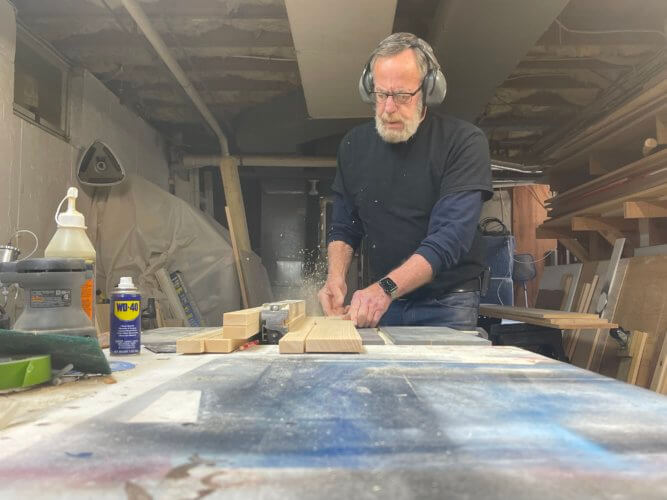
“I’ve done it at every branch of the service,” Card says. Requests have included putting the Navy SEALs’ Special Warfare insignia — an eagle clutching a U.S. Navy anchor, trident, and flintlock-style pistol — and the Marine Corps emblem – the eagle, globe, and anchor — on the flag. Some items have even been done in gold leaf.
He’s also made flags in honor of New York City police officers killed in the line of duty.
Card has always felt strongly about the flag. “I’m a fanatic for flags,” he says.
A former sergeant in the Marine Corps and a 40-year member of the Sag Harbor Fire Department, service is important to him and the flag is the ultimate symbol.
As a Vietnam veteran who served four years, “I’ve buried a lot of guys. I’ve folded a lot of flags,” he says.

Following the Sept. 11 terrorist attacks, “I spent three months down at the Trade Center after the towers went down.” He says he was one of four volunteers who got to stand on the ramp during the closing ceremonies and he carried one of 343 flags (one for each of the firefighters killed).
“I used to carry around 20 flags in my truck, I used to get ‘em from the lumber yard. They were like 12 bucks a piece,” he recalls. If he saw a tattered American flag flying, he would replace it and offer to take the worn-out one to the American Legion, where they are disposed of properly in a flag-burning ceremony.
Asked what the flag means to him, he says simply: “God. Country. Freedom.”
“I just always had a thing for the American flag. I mean, there’s nothing more beautiful. Seeing the American flag flying,” he continues.
“I’ve gotten grief online from different people saying, ‘You desecrate the flag’,” says Card, but he knows the protocols all too well. “No, I’m not. That’s a facsimile of a flag. A flag is a cloth object that’s made. That’s the difference,” he explains.”
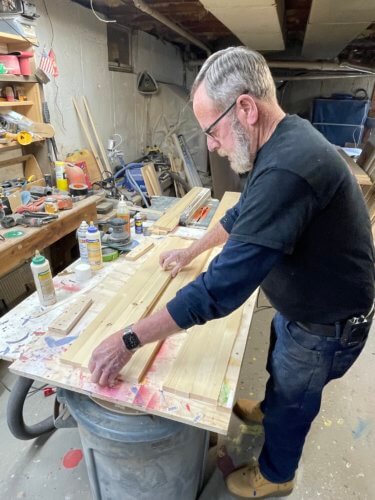
Several of the flags he’s made have been in honor of New York City firemen who have died of 9/11-related illnesses, like Ray Pfeifer who fought for healthcare benefits for those who survived the terrorist attacks and spent time digging for survivors and bodies. In 2017, he died from complications of cancers.
The process of making the flag signs begins with a 1-by-12-foot piece of pine that he buys from Riverhead Building Supply and then cuts into inch-and-a-half-wide strips with a table saw. “I’ll rip up 13 pieces of pine and this is my jig,” he says, showing his setup. “And then I’ll just stack them all.”
He reorganizes the stack on his table and points to a knot on one of the pieces of wood. “When you have a knot, you make that come up in the union (section) because that’s gonna be dark blue, you won’t even see it,” he explains.
He uses a wedge to keep the 13 pieces together while he attaches them with wood across the back. Next comes the sanding to smooth the wood.

After the Old Glory Blue paint is applied in the union, he puts on the first coat of sealer. Then it’s ready for the 50 white stars in the canton on the upper left, done with a stencil. If there is any lettering or writing on the particular flag sign he is working on, he’ll do that next.
Though Old Glory is, of course, red, white and blue, few of his designs have white on the stripes “because everybody likes the more natural look, instead of being a bright white.” He takes a torch to the wood to give it a rustic look.
It takes him four to five hours each to complete a standard flag.
He applies four coats of exterior water-based polyurethane. “They’ll last,” he says. “They hang up. You could leave them outside in the weather. Nothing’s gonna happen to them.”
It doesn’t feel like work to him. “This is therapy. It keeps the mind going.”
“Everybody says that, you know, it’s artwork. No, it’s not. It’s the flag!” Card says.
Does he consider himself a craftsman?
“I don’t know. I would say I’m a good woodworker. Craftsman is a big word. Now you could take a craftsman — he could build that table 25 times that’d be exactly the same. Every time, the finish looks good and everything else. A good woodworker could do the same thing, but he can make that more, 10 other variations of that.”
“I enjoy what I do. I mean, that’s the other difference. You have to like what you’re doing. A lot of guys go to work every day, but it’s just a job, right? I don’t. I’ve never done that.”
This article appeared in the July 2022 edition of Behind The Hedges. Read the full digital edition here. For previous Master Craftsman columns, click here. Have a Master Craftsman to recommend? Email tvecsey@danspapers.com.
